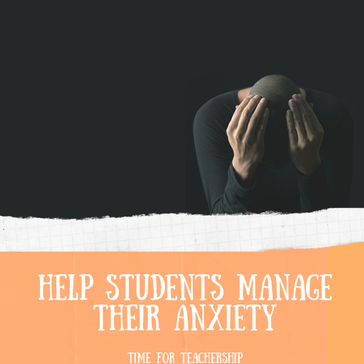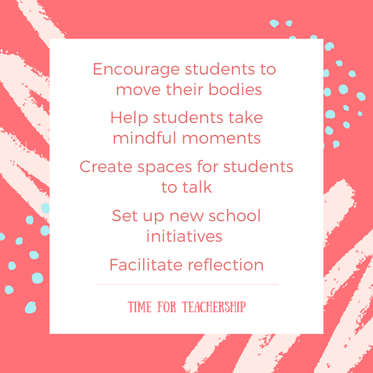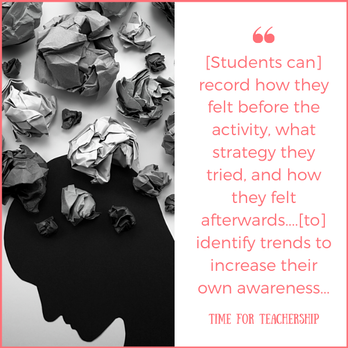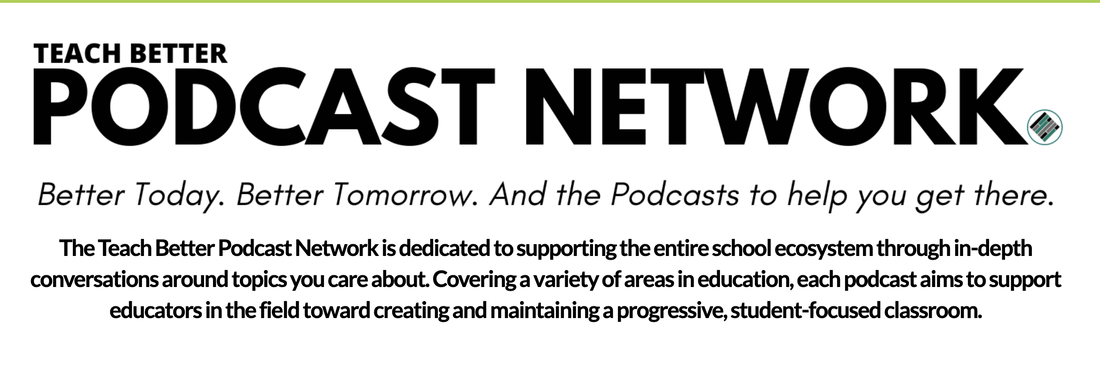|
Many students are experiencing high anxiety without the usual relational supports like seeing teachers and peers in person. Many students have been impacted by death this year—from disease and racist violence— and the resulting fear for their own safety and the safety of family members can be overwhelming. There is much to do to resolve these larger issues of systemic racism and a pandemic, but let's think about how we can support students to manage their anxiety in the moment. As a teacher, sometimes I forgot to teach coping strategies as part of a lesson, but it’s important to do so. Not all students have coping strategies, or they may have coping strategies that are unhealthy or ineffective. So, it’s up to us to explicitly teach students a variety of strategies they could use to cope with stress, thus enabling each student to make an informed choice about what works best for them. Encourage students to move their bodies. Research has shown that physical activity can reduce anxiety and depression. Some students may have physical limitations on how they are able to move their bodies, so provide a range of options here. If students have a phone, they can track their steps over the course of a day or a week. They can exercise by running, doing bodyweight activities like squats or pushups, or following along with an online fitness video. Help students take mindful moments. Some students may want to use a simple strategy like breathing deeply for 60 seconds. Others may need more structure. Here are some options you could offer: Suggest a breathing strategy like smell the flower (inhale), and blow the bubbles (exhale) or balloon breathing (lifting arms over the head on an inhale to “blow up the balloon” and bringing arms back down on an exhale to “deflate the balloon”). Tell students about guided meditation sites like Stop Think Breathe (there’s one for older students and one for younger students), Calm, or GoNoodle (this one’s typically for young students). To help bring mind and body back into the moment, take a minute to experience each sense. One at a time, focus your attention on your sense of sight (e.g., identify 5 objects in your space), then sound (e.g., notice what you hear around you), then touch (e.g., touch 2-3 different textures around you), then smell (e.g., notice what you smell), and finally, taste (e.g., if you are eating or drinking). Create spaces for students to talk. If you have the time and emotional capacity for this work, this space could be facilitated by you as the teacher. However, recognizing that emotional labor takes its toll on the facilitator, you may also want to suggest other places for students to go. This might be a school-based resource like counseling, or an anonymous online space like ADAA’s online support group. Set up new school initiatives. How could we think outside the box to dream up innovative ways to support students’ mental health moving forward. Is it possible to partner with a local organization to offer animal therapy at your school? Is it possible to designate a room as a mental health break room where students can take some deep breaths or even a quick nap? Could you help students start a club to raise awareness of youth mental health? Facilitate reflection. You may want to set up a reflection space (either private or public to other students) for students to record how they felt before the activity, what strategy they tried, and how they felt afterwards. This way, students can identify trends to increase their own awareness of their bodies and moods. If you set up a community space for your class to share these insights publicly, some students may benefit from the additional accountability and/or learning from their peers’ strategy uses or “aha” moments. Taking time to teach these practices and help students identify the ones that work best for them is investing in students’ lifelong abilities to be more present and resilient. This is especially helpful for students who have experienced trauma, which research tells us, is the case for most of our students.
0 Comments
Leave a Reply. |
Details
For transcripts of episodes (and the option to search for terms in transcripts), click here!
Time for Teachership is now a proud member of the...AuthorLindsay Lyons (she/her) is an educational justice coach who works with teachers and school leaders to inspire educational innovation for racial and gender justice, design curricula grounded in student voice, and build capacity for shared leadership. Lindsay taught in NYC public schools, holds a PhD in Leadership and Change, and is the founder of the educational blog and podcast, Time for Teachership. Archives
May 2024
Categories |





 RSS Feed
RSS Feed